The interwar Spanish Cruisers
Called different names by historians according either to their launching or completion date, these three Spanish cruisers were a departure of WW1 design, and built in Spain, at Ferrol NyD (Sociedad Española de Construcción Naval). They were light cruisers with strong British influence, designed by Sir Philip Watts in person. They recalled the British Enterprise-class but all their boilers were grouped together to reduce the number of funnels. Main armament was made of Vickers pattern 6-inch guns in single mountings and twin turrets, this was the major attraction of this design compared to previous vessels of the Blas de Lezo class. The programme was initially authorised so-called Miranda law of 17 February 1915. However due to the lack of support of UK to send parts, it was delayed after 1916, construction of the lead ship starting in 1917. The design was revised in between as parts arrived and they were completed in 1925-1930. By that time, their design was already dated, comparable with the American Omaha class and British E class because of their mix of twin and single guns.
Both would served extensively during the Spanish civil war, Alfonso being renamed in 1931 Libertad. Both Libertad and Cervantes served with the Republicans, but Cervera was captured and used by the Nationalists. Galicia (ex-Libertad, ex-Alfonso) and Miguel de Cervantes were partly rebuilt and comprehensively refitted in the 1940s with the “Q” 6-in turret replaced by a catapult and seaplane while their single broadside 6-in mountings were replaced by twins and AA added. They were discarded in the 1960s, 1970 for Galicia.
Design of the Cervantes class
Like for previous designs, the Spaniards turned to British yards to have plans of the latest light cruisers of the new generation built in Great Britain. This were the E-class (Enteprise or Emerald) of the Royal Navy. designed by Sir Phillip Watts’ team they were very similar in dimensions but different internally and externally in a great number of details:
-For aesthetical and practical reasons (pierced funnels were a problem for draft, therefore less funnels the better) and aesthetic ones, the entire compartmentation of the powerplant was revised, as much as for ASW protection than to concentrate funnel exhausts in a single point. Plus with their two raked funnels these cruisers were elegant. One was even called the “dandy of the bay of Biscaye”.
-They also had single and twin masked guns: Enteprise had a twin turret forward, and singles everywhere else, while Emerald only had single ones.
-They carried eight guns rather than seven, which proved a better choice, with an overall better arc of fire.
-They diverged in dimensions, being much longer (176.63 vs. 173.7 m), slightly broader, with slightly more draft, and of course larger displacement.
-They had an aft mainmast, and minimal rigging forward
-Details of their bridge and fire director also diverged
-However just as the Emerald, they were quite fast. The Emerald reached 32 knots, the Cervera 33 knots.

HMS Emerald, on which the design was based. In reality, they were base don her variant, HMS Enterprise, which had twin guns fore and aft. They had eight guns in all, wit varying positions between the two prototypes. The Arethusa and Leander directly derived from them.
Hull and protection
The Cervera class cruisers had a conventional hull shape with a forecastle starting right after the first funnel. From afar they almost looked as destroyers with their fore and aft superfiring gun positions. The stern was raked, the bow almost straight and they did not have the breakwater recessed in the bow’s flanks of the Emerald class. Their speed also came from their shape, with a good 1/10 lenght-beam ratio. Protection was light, comprising a 75 mm belt armour (3 in), 40 mm (1.5 in) on both ends, and had two decks, a protective deck above the waterline, 50 mm strong (2 in), an upper deck 25 mm strong (0.9 in). Only the conning tower was well protected, with walls 150 mm strong (5.9 in). Thickness of the gun shields is unknown, but probably the same as the Emerald, 3-in (75 mm). These figures were slightly better than the E-class.
Powerplant
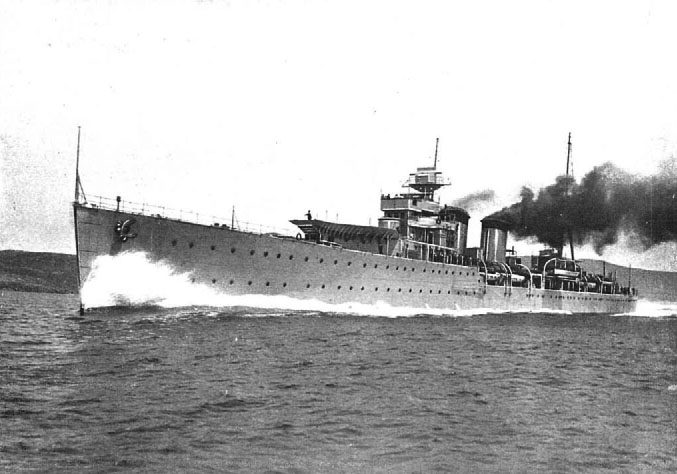
Cervera on trials 1928
The Cervera class became the fastest cruisers of the Spanish Navy, they were capable of leading destroyers, conceding just three knots to the Churrucca class (36). This consisted in four Parsons geared turbines, for one shaft each, fed by eight yarrow boilers, producing 80,000 hp, enough for 33 knots (61 km/h; 38 mph). Range was helped by the fact the were oil-burning, and were noted for 5,000 nmi (9,300 km; 5,800 mi) at 15 knots (28 km/h; 17 mph), lesser than the E-class, capable of reaching 8,000 nm at the same speed. On trials, Alfonso achieved 34.7 knots, a record at that time, for an output of 83,000 shp. These figures did not held the test of time and especially the civil war. By the end of the war, the lack of maintenance, probably had them reaching barely 30 knots.
Armament
It was entirely British, and consisted in eight main guns, four secondary, two light and four triple banks of TTs.
The 6-inch (152 mm) guns were placed in three twin turrets, all on the upper positions, “B”, “X” position and amidship, and two single mountings on the decks, “A” and “X” positions. They were of the typical Breech Loading 6-inch (152 mm) L/45 Mk XII also used on the Emerald. They fired a 100 pounds (45.36 kg) Lyddite, Armour-piercing, Shrapnel (2,825 feet per second (861 m/s)). They used a Welin interrupted screw breech, with a recoil Hydro-spring system at 16.5 inches (420 mm). The mount elevated to 30°, for a max range of 19,660 metres (21,500 yd. The average rare of fire was 5-7 rpm.
The four 4-inch (102 mm) guns were 45 caliber dual purpose, AA guns, located either side of the rear deckhouse, near the tripod mainmast and aft superstructure bridge and aft funnel, on side platforms with a good arc of fire. This was completed by two 3-pd (47 mm) guns moslty used as saluting pieces.
The most impressive part of their arsenal was the presence of twelve 21-inch (533 mm) torpedoes in four triple banks on the broadside. Due to the recesses in the superstructure, they could pivot to 90°. This gave them the equivalent of a destroyer full torpedo broadside on each side, a potent mix combined with their speed.
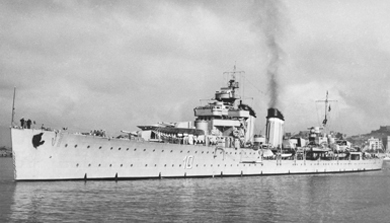
Cervera in WW2 – src todoavante.es
Specifications in 1920 |
|
| Dimensions | 176.63 oa (166.12 pp) x 16.45 x 5.03 m |
| Displacement | 7,475 long tons standard, 9,237 long tons Fully Loaded |
| Crew | 1044 total: 564 officers and enlisted men |
| Propulsion | 4 shafts parsons turbines, 8 WT Yarrow boilers 80,000 shp |
| Speed | 33 kn (61 km/h; 38 mph) 5,000 nmi |
| Armament | 8 × 6in (150), 4 × 4in (102), 2x 3pdr, 12x 21-in (533 mm) TTs |
| Armor | Belt: 40-75 mm, Decks: 25-50 mm, CT 150 mm |
Cervera class modernization
After 1945, the Spanish minister of the Navy plan a modernization for many ships, including the three Cervera class cruisers. It was “project nº 133”. It included the addition of a Heinkel He 114 seaplane and revised catapult, and redistribution of all main guns into four twin turrets. A French Decca radar was also to be provided and the bridge rebuilt and modernized as well as extra AA added. Some of these planned upgrades were actually made on Galicia and Miguel de Cervantes. However Cervera was never taken in hands for such modernization as both financial support was not there, and the lack of materials also prevented it. Therefore she was retrograded as a part-time training ship, spending the rest of her career as a training ship until 1965. Her sister-ships survived her longer.

Src/Read More
Chesneau, Roger, Conway’s All the World’s Fighting Ships 1922–1946.
Whitley, M. J. (1995). Cruisers of World War Two
navypedia.org/ principe_alfonso class
world-war.co.uk principe de Alfonso class
Cruceros_clase_Cervera
Almirante_Cervera-class_cruiser
en.wikipedia.org/ Spanish_cruiser_Almirante_Cervera
The Cervantes class in service
 Almirante Cervera
Almirante Cervera
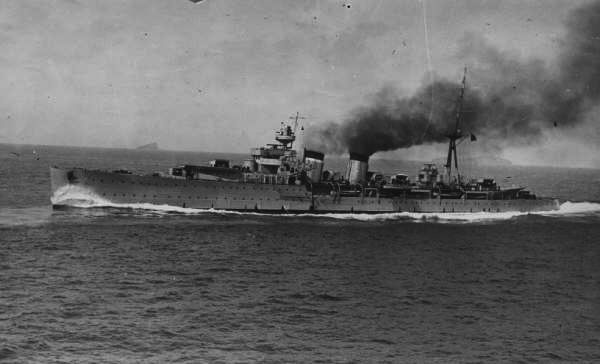
Named after the admiral Cervera di Topete which fought at the battle of Santiago de Cuba, the cruiser was launched in Ferrol on October 16, 1925, sponsored by the wife of Admiral Emiliano Enríquez. Sea trials started on May 24, 1928, a week and she was commissioned on 15 September 1928. In November 1928, she participated in exercises off the Balearic Islands, hosting King Alfonso XIII, which reviewed the squadron. On April 13, 1929, she visited to Lisbon, while the staff was visited by the President of the Republic nd the government visited the ship on 18 April.
16 May 1929: Cervera sailed to Havana, Cuba, carrying a Spanish delegation led by the Minister of the Navy Admiral Mateo García de los Reyes. They were invited for the inauguration of the President of the Republic, General Gerardo Machado. She departed to spain ten days later.
The Second Spanish Republic was proclaimed in 1931 with Francisco Bastarreche at its head, alternating between her as flagship and the destroyer Alcalá Galiano. In October 1934, Cevera shelled coastal towns during the insurrection in Asturia together with the battleship Jaime I. In early 1936, she made an artillery exercise with Jaime I and her sister ships Libertad (ex-Alfonso) and Cervantes, targeting the old unprotected cruiser Conde de Venadito.
When the civil war broke out in July 1936, Admiral Cervera was in El Ferrol, drydocked for a refit her two sister ships never had. She was left under Republican sailors which led her, until the 21st, when the port was attacked by officers and sailors of the Nationalist side. After much fighting she was captured and passed under General Francisco Franco control (in command in october). She was initially under command of captain Juan Sandalio Sánchez-Ferragut, shot by the Nationalists. Cervera was nicknamed “El Chulo del Cantábrico“, the “dandy of biscaye”, as she multiplied mining missions, blockading Republican ports along the coast and shelling coastal towns with impunity, like Gijón, Santander or Portugalete, the Republican submarine base.
Cervera was dispatched to Gijón to help rescuing besieged troops after the Simancas Barracks attack. She was later in a task force, which centerpiece was the battleship España and destroyer Velasco, sent to blockade the Cantabrian coast and shell any meaningful objective. Howeber on August 9, 1936 Cervera hit the British yacht Blue Shadow, targeted as she was coming from Bilbao, carrying British citizens evacuated conducting them off Gijón. Cervera was shelling the port and commander spotted the Blue Shadow, misidentified it for a WW1 ASW vessel. He opened fire, killing the captain Rupert Savile, wounding his wife, two crew members and wounding the passengers. The ship sank quickly, survivors being rescued by the British destroyer HMS Comet, coming from the port of El Musel. This trigerred a diplomatic incident, however due to the alliances of the Nationalists with Italy and Germany, the matter was dropped.
Cervera was also sent to support the blockade of the Strait of Gibraltar. As Republican covoys transited, Cervera participated on 29 September 1936 to the battle of Cape Spartel, duelling with the Republican destroyer Gravina with poor results: She fired 292 6-in rounds for just two hits. Gravina was damaged but managed to escape at full speed, taking refuge in Casablanca. By October 1936 the coast guards Uad Lucus and Uad Muluya were scuttled off Malaga after Cervera showed up.
By January 1937 the spanish cruiser accompanied by the gunboat Galerna spotted, and catch the Panamanian-flagged merchant Andra, sank as she carried various cargoes, circumventing the blockade of the Cantabrian Sea. After a second volley she was disabled but proved impossible to tow, so she was sunk by Galerna.
Cervera went on doing these blockading duties, spotting, identifying and capturing merchant ships of various flags passing by since it started on April 6, 1937. She was about to capture a British merchant ship Thorpehall, when she was catch by three destroyers and escorted to safty to Bilbao. After this, the situation became even more tense:
On 21 April, Almirante Cervera and Galerna faced the British battlecruiser HMS Hood and destroyer HMS Firedrake for three hours, trying to sink three British merchantmen. After hood warned by projector the Cervera, then fired warning shot, the freighters escaped into Bilbao a coastal battery and the Basque armed trawler Biskaya taking charge of their protection. On 4 July, Cervera seized the French steamer Trégastel and fired on the British Latymer off Cantabria, which was chased off. Both tried to enter Santander, despite the presence of the battleship HMS Resolution, under stricts orders not to fire. On 9 july British merchant ship SS Gordonia was also intercepted and arrested to be inspected. She was released and escorted away by British warships. On 14 July Cervera and Galerna, seized the Molton off Santander. It happened inside Spanish waters, under the eyes of the battleship Royal Oak, which could do little but prevent any sinking. Cervera would sank later two Republican coast guard vessels and a merchant ship and shot down a Tupolev SB bomber which targeted her. The Spanish cruiser also played a central role in the capture of the Marqués de Comillas, a liner loaded with Republican 9,000 troops. This is how 1937 ended, quite a remarkable career.
On 17 February 1938, Cervera sailed from Palma de Mallorca with Canarias and Baleares for the shelling of Valencia and on the 22 she was strafed by Republican biplanes Polikarpov R-Z (Soviet Group 30, Soviet pilots but Republican markings) and a second wave of Tupolev SB. She was hit by a 50 kg bomb on the stern funnel, which was a dud, but the impact shatterred the funnel and wounded 25 men, the machine room was also damaged. Other reports another bomb hit, eve more serious, but never confirmed. On 6 March, she escorted a convoy, ending in the Battle of Cape Palos, assisting the Baleares, which that day was torpedoed and sunk by Republican destroyers, rescuing survivors.
On 23 October 1938, she seized the Soviet steamer Tsyurupa. She was renamed Castillo Villafranca and used by the Nationalists. Despite of her near constant service off a shrinking Republican-held coast, the career of the Cervera was somewhat was shiny than the cruiser Canarias. The civil war ended and the cruiser was now showing her age. She received a limited upgrade in 1938-39 but stayed in the same state during WW2. Cervera was not modernized extensively as her sisters after the war, served as a training ship until was written off in 1965.
 Principe de Alfonso
Principe de Alfonso
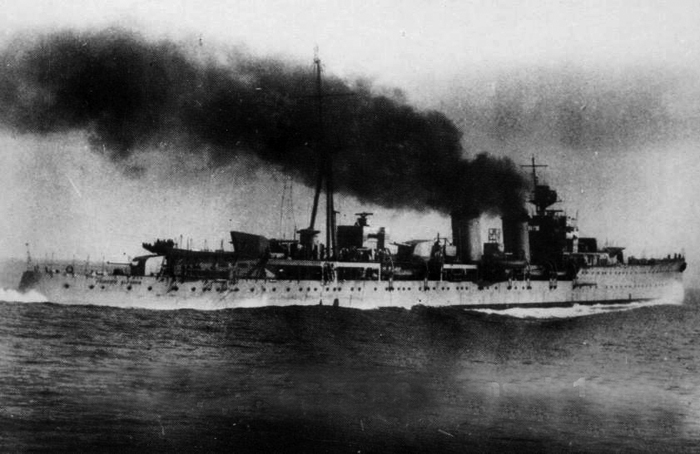
Authorized in July 11, 1922, laid down on November 24, launched in January 3, 1927 in Ferrol, Alfonso started her sea trials in September 1927 and by November 1927, carried the king of Spain from Barcelona to Naples for marriage of Princess Anne of France with the Duke of Apulia. The cruiser then stopped for state visits at Malta, Bizerte, Sardinia and Mahón. By the summer of 1928, the King was back on board to assist in the Bay of Santander to the French Atlantic Squadron (Admiral Docteur) visit. King Alfonso XIII visited Sweden in September 1928 and stopped in Kiel. He attended a reunion with Rear Admiral Woelping von Ditter, Vice Admiral Oldekop, Vice Admiral Erich Raeder and Captain Wilhelm Canaris onboard SMS Schleswig Holstein. The ship then transited the Skagerrak, stopping at Stockholm and Gothenburg and returned to Spain via via Skagen, Courtepin in Scotland, Plymouth, arriving in Ferrol in September for a quick overhaul. The king assisted to the fleet’s exercizes off Santander in August 1929 and the great autumn maneuvers in the Mediterranean. However wit the revolution of 1931, the King took exile onboard the cruiser, heading from from Cartagena to Marseille in April, but returned to Cartagena as the Republicans ordered. She was renamed soon Libertad.
Under the Republican flag, Libertad carried Gneral Sanjurjo to Ceuta on April 24, 1931 and later teamed with Cervantes and Cervera to carry troops during the Asturias Revolution of 1934. They landed loyal troops in El Musel, sending their own Marine companies. By October 6-7, Libertad carried and landed the 29th Infantry Regiment in Gijón and fired on the Cimadevilla. The following day she carried out the same mission, adding the Cerro de Santa Catalina as well, with Cervera and Jaime I. By October she remained in El Musel and became in july 1936 when the civil war broke out the flagship of the Republican Navy. She became the most active and efficient Spanish cruiser. She was in Ferrol when the war broke out, and she headed with Jaime I and Miguel de Cervantes to Cádiz. However their commanders leaned towards the Nationalist cause, and during the trip, the crews mutinied and tok control of the three ships, their Officers being shot or jailed. The fleet as ordered headed for Tangier and started a blockade.
On July 20, 1936, Libertad and the fleet shelled Ceuta and two days later with Cervantes, she shelled Algeciras and La Línea. The International Committee however ordered them to leave Tangier, an international city. The cruisers staued in Malaga, trying to maintain strait the blockade in international waters. On August 7, Libertad and Jaime I shelled Cádiz and Algeciras. They sank the gunboat Dato. Later they assisted a failed attempt to land and conquer Mallorca. By September, teaming with Jaime I, Cervantes and five destroyers she headed for Malaga and left the Strait of Gibraltar to support isolated republican forces in northern Spain. Some shelling of the Cantabrian coats were followed by an order to sail back to the Mediterranean, crossing at night the Canarias and Almirante Cervera. They were sighted and therefore no battle followed. By April 1937, Libertad, Jaime I and Méndez Nuñez shelled Malaga. She sortied in May for a similar mission.
In September she teamed with Méndez Nuñez and the destroyers Lepanto, Almirante Valdés, Almirante Antequera, Almirante Miranda, Gravina, Escaño and Jorge Juan, to escort a convoy. However en route off Cape Cherchell (Algeria) they met the cruiser Baleares. The battle raged on for one gour, Libertad being hit by Baleares, but hit her in return twice, setting her ablaze. The republican then withdrawn to Cartagena, being strafed and bomb on their way by national and Italian planes. Libertad was then repaired and inactive until March 1938. The same republican squadron face the Nationalists at the battle of Cabo de Palos. Libertad shot 13 time while the destroyer Lepanto sank the Baleares, one of her torpedoes hitting bow ammunition store. There are little active records aferwards, until on March 5, 1939, Cartagena uprizing forced the cruiser out, with the rest of the Republican squadron, sailing to for Bizerte in Tunisia to be interned. They arrived on March 11 and the crew requested political asylum, while others were internet at Meheri Zabbens camp. The crew was later repatriated on the Mallorca and Marqués de Comillas transports, departing in late March 1939.
Later, the ship was asked for by the new Francosit government and went back in service. Libertad was renamed Galicia and spent WW2 in inactivity. She was modernized however in the 1940s and handed over to the Armada in December 13, 1944. In 1946 Galicia sailed to Buenos Aires, to represent Spain at the inauguration of President Juan Domingo Perón. Her active service went on until
January 1970. She was then discarded, and sold for scrap.
 Cervantes
Cervantes
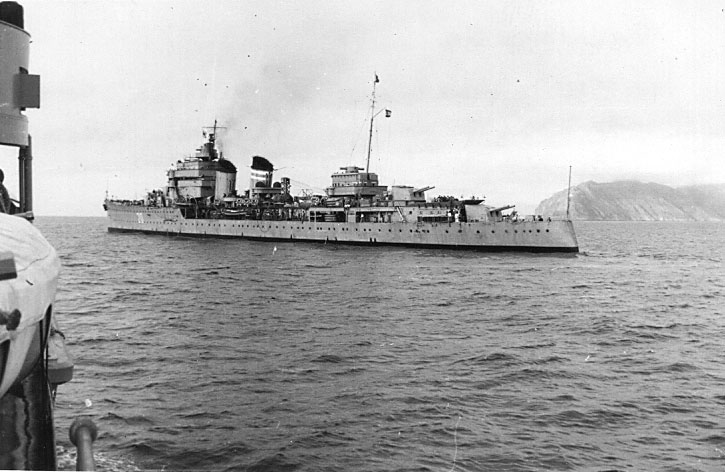
Named after the famous writer, the cruiser made her sea trials in December 1929 nefore commissioning. She showed her amazing speed, reaching 35 knots, the best of the three, superior to many destroyers of the time. She teamed with Almirante Cervera during the Asturias Revolution of 1934 (see above) shelling objectives and landing troops. With Libertad sailed from Ferrol on July 17, 1936, heading to the Strait of Gibraltar when the civil war started, trying to blockade the strait. Crews rebelled onboard and seized the ships from officers largely sympathetic to the Nationalists. She then teamed with Jaime I, Libertad, and seven destroyers (Churruca class), blockading Tangier and the strait of Gibraltar. They shelled La Línea de la Concepción, Ceuta and sailed for their new base in Malaga. They briefly sailed to northern Spain and were ordered back to Cartagena.
On November 22, 1936, Miguel de Cervantes was hit by torpedoes fired by the Italian submarine Torricelli as she was anchored off Cartagena. Damage was seruious but her ASW compartimentation did its job and she was towed to the port’s basin for repairs. They lasted until April 1938. She was only operational again, after months of inactivity, in March 5, 1939. She had to left Cartagena like the rest of the Republican squadron, and headed for Bizerte for internement; The crew was later repatriated and the ship claimed after the war by the new government. Her carried was quiet in WW2. She received a modernization like her sister. In 1949, she carried El Caudillo to Lisbon and later in May 1952, to Barcelona, for the celebration of the XXXV International Eucharistic Congress. She also landed ans assisted Spanish soldiers during the war of Ifni in North Africa. After her long career, she was decommissioned in 1964, sold for scrap.

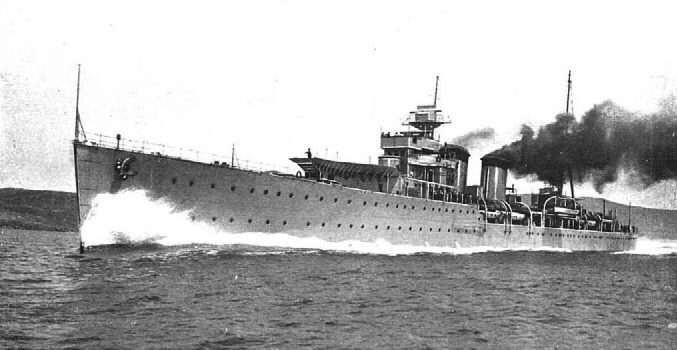


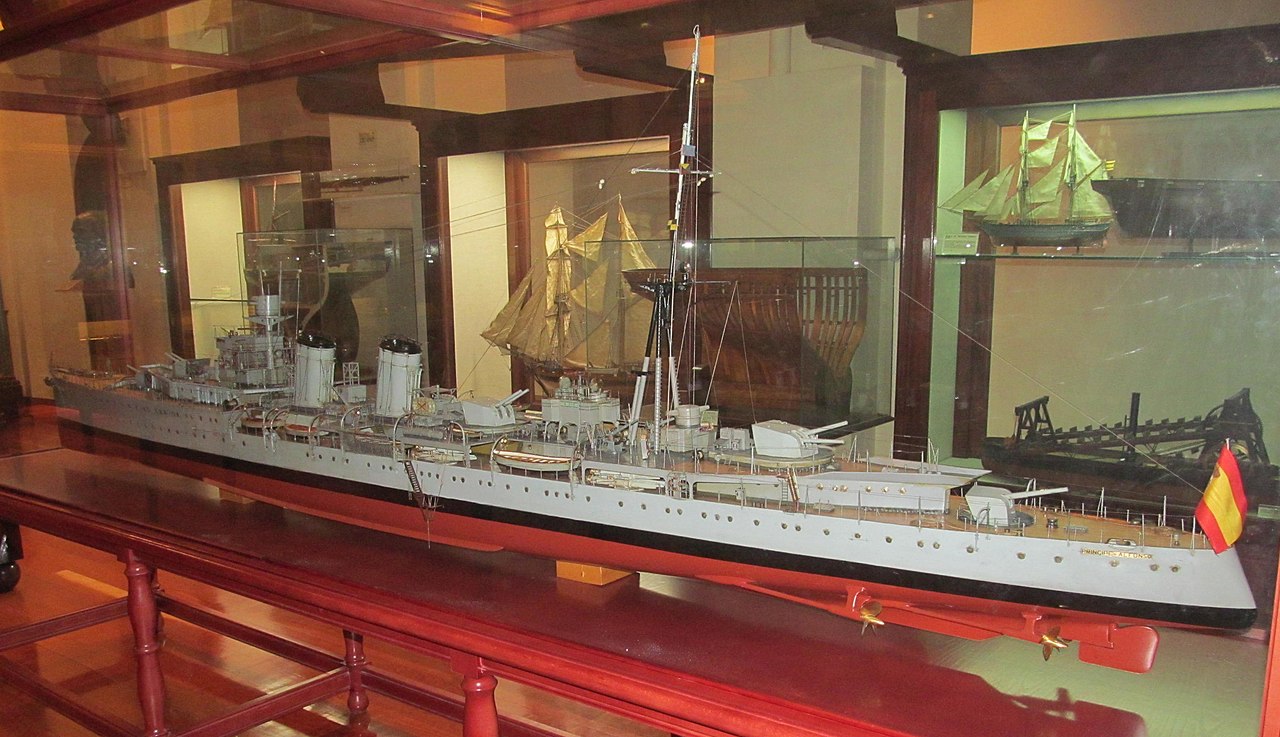
 Latest Facebook Entry -
Latest Facebook Entry -  X(Tweeter) Naval Encyclopedia's deck archive
X(Tweeter) Naval Encyclopedia's deck archive Instagram (@navalencyc)
Instagram (@navalencyc)





 French Navy
French Navy Royal Navy
Royal Navy Russian Navy
Russian Navy Armada Espanola
Armada Espanola Austrian Navy
Austrian Navy K.u.K. Kriegsmarine
K.u.K. Kriegsmarine Dansk Marine
Dansk Marine Nautiko Hellenon
Nautiko Hellenon Koninklije Marine 1870
Koninklije Marine 1870 Marinha do Brasil
Marinha do Brasil Osmanlı Donanması
Osmanlı Donanması Marina Do Peru
Marina Do Peru Marinha do Portugal
Marinha do Portugal Regia Marina 1870
Regia Marina 1870 Nihhon Kaigun 1870
Nihhon Kaigun 1870 Preußische Marine 1870
Preußische Marine 1870 Russkiy Flot 1870
Russkiy Flot 1870 Svenska marinen
Svenska marinen Søværnet
Søværnet Union Navy
Union Navy Confederate Navy
Confederate Navy Armada de Argentina
Armada de Argentina Imperial Chinese Navy
Imperial Chinese Navy Marinha do Portugal
Marinha do Portugal Mexico
Mexico Kaiserliche Marine
Kaiserliche Marine 1898 US Navy
1898 US Navy Sovietskiy Flot
Sovietskiy Flot Royal Canadian Navy
Royal Canadian Navy Royal Australian Navy
Royal Australian Navy RNZN Fleet
RNZN Fleet Chinese Navy 1937
Chinese Navy 1937 Kriegsmarine
Kriegsmarine Chilean Navy
Chilean Navy Danish Navy
Danish Navy Finnish Navy
Finnish Navy Hellenic Navy
Hellenic Navy Polish Navy
Polish Navy Romanian Navy
Romanian Navy Turkish Navy
Turkish Navy Royal Yugoslav Navy
Royal Yugoslav Navy Royal Thai Navy
Royal Thai Navy Minor Navies
Minor Navies Albania
Albania Austria
Austria Belgium
Belgium Columbia
Columbia Costa Rica
Costa Rica Cuba
Cuba Czechoslovakia
Czechoslovakia Dominican Republic
Dominican Republic Haiti
Haiti Hungary
Hungary Honduras
Honduras Estonia
Estonia Iceland
Iceland Eire
Eire Equador
Equador Iran
Iran Iraq
Iraq Latvia
Latvia Liberia
Liberia Lithuania
Lithuania Mandchukuo
Mandchukuo Morocco
Morocco Nicaragua
Nicaragua Persia
Persia San Salvador
San Salvador Sarawak
Sarawak Uruguay
Uruguay Venezuela
Venezuela Zanzibar
Zanzibar Warsaw Pact Navies
Warsaw Pact Navies Bulgaria
Bulgaria Hungary
Hungary

 Bundesmarine
Bundesmarine Dutch Navy
Dutch Navy Hellenic Navy
Hellenic Navy Marina Militare
Marina Militare Yugoslav Navy
Yugoslav Navy Chinese Navy
Chinese Navy Indian Navy
Indian Navy Indonesian Navy
Indonesian Navy JMSDF
JMSDF North Korean Navy
North Korean Navy Pakistani Navy
Pakistani Navy Philippines Navy
Philippines Navy ROKN
ROKN Rep. of Singapore Navy
Rep. of Singapore Navy Taiwanese Navy
Taiwanese Navy IDF Navy
IDF Navy Saudi Navy
Saudi Navy Royal New Zealand Navy
Royal New Zealand Navy Egyptian Navy
Egyptian Navy South African Navy
South African Navy






























 Ukrainian Navy
Ukrainian Navy dbodesign
dbodesign